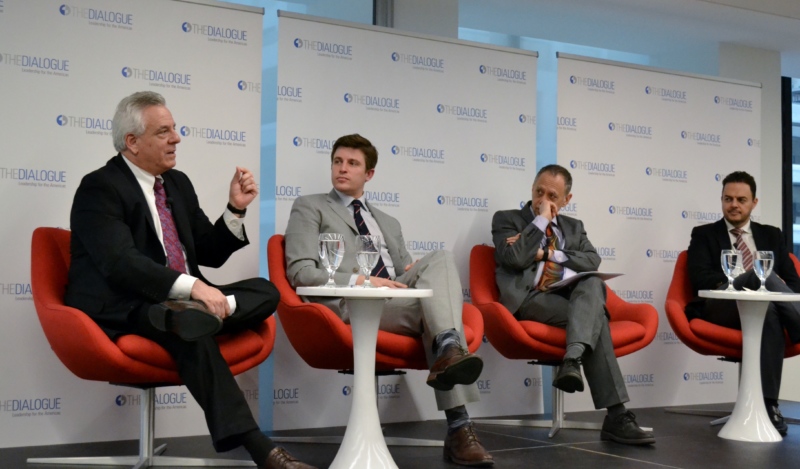Rising Brazil: The Choices Of A New Global Power
What should we expect from a newly powerful Brazil? Does the country have the capacity and leadership to be a central actor in addressing critical global and regional problems?
On February 23, the Inter-American Dialogue’s Education Program hosted a panel discussion around “Workforce Development in the Americas: Lessons from Brazil and the US” in which panelists from Brazil and the United States shared insights on best practices in workforce development, particularly the role that private companies play in these efforts. The panel included Frederico Lamego, Executive Manager for International Relations at the National Service for Industrial Training (SENAI) in Brazil, Eric Seleznow, Senior Advisor at Jobs for the Future, and Brent Parton, Deputy Director of the Center on Education and Skills at New America, and was moderated by Ariel Fiszbein, the director of the Education Program at the Inter-American Dialogue. The panelists discussed their experiences with workforce development, the challenges they face, and the lessons that can be learned through an inter-regional perspective.
The session began with an overview of the work of SENAI. Founded in 1942 by the Brazilian Confederation of Industry, SENAI is a nationwide organization that promotes vocational and advanced training in industry. It currently has 2.7 million students in approximately 500 schools and 500 mobile units throughout Brazil. In analyzing SENAI’s success and credibility in the country, Lamego emphasized the importance of their relationships with the private sector as well their mechanisms for analyzing and anticipating job market trends. Lamego reported that a recent study on SENAI alumni found that 65% of their graduates had kept their job, found a new job related to their industrial expertise, or maintained their salary and added that these figures were even higher before the Brazilian economic crisis. Looking toward the future, Lamego hopes to increase the scope of SENAI’s reach in Brazil (they currently reach only 9% of the population ages 16-21) and push the technical education agenda to the forefront.
Focusing on the US perspective, Parton stressed that one of the challenges of workforce development is the disconnect between what students are learning in the classroom and the skills that are needed in the labor market. He identified various solutions to address this issue, including increasing the scale of public-private partnerships, augmenting employer engagement, and making employers co-producers of the curricula that decides what skills students learn. He also acknowledged the various challenges to achieving these goals, such as the difficulty of establishing public-public partnerships, stigmas around technical education, and importantly, the lack of coherence that many times exists between education levels. Parton was, nonetheless, hopeful about the future. He stated that the US is entering a new era in which civil society, the government, academia, and institutions are rediscovering the importance of technical education and career readiness is being emphasized along with college readiness.
Echoing the need to reduce the gap between what employers need and what students are learning, Seleznow talked about the use of apprenticeships as tools for bridging this gap. He emphasized the significant benefits that apprenticeship programs have had in the US, such as providing competitive wages upon completion, resulting in higher school retention rates, and providing hands-on learning. However, he also recognized the limits of apprenticeships: namely, the limited reach of apprenticeships in the US, the lack of a centralized workforce development system to coordinate apprenticeships, and the fact that in the US, in contrast to other countries such as Brazil, apprenticeships are geared towards adults (the average age of US apprentices is 29). As a result of these limitations, he concluded that while apprenticeships are an effective tool, they should be a part of an arsenal of other tools to address workforce development. Moving forward Seleznow hopes to see the creation of a centralized workforce development system like SENAI, in the United States, and increased youth participation in these programs.
There was consensus among the panelists that employer involvement and engagement is crucial to the success of technical education and workforce development. Specifically, they stressed the importance of involving the private sector in every step of the process, not just as consumers of the “final product.” They also shared concern for the stigma attached to technical education and the need to adapt policies to reach and include special populations such as underprivileged youth, youth with disabilities, etc.
Finally, the panelists agreed that both Brazil and the United States face similar difficulties in the task of improving and implementing workforce development, but also that they can learn from each other. Parton and Seleznow, for example, expressed their belief that a national, cohesive organization similar to SENAI could be a tremendous tool for workforce development in the US Additionally, they would like to emulate Brazil’s focus on youth rather than adults. Looking towards the future, the panelists hoped to strengthen these aspects and, in general, bring workforce development to the forefront of policy agendas.
What should we expect from a newly powerful Brazil? Does the country have the capacity and leadership to be a central actor in addressing critical global and regional problems?
President Lula da Silva triumphantly announced that he and his Turkish counterpart had persuaded Iran to shift a major part of its uranium enrichment program overseas—an objective that had previously eluded the US and other world powers. Washington, however, was not applauding.
An upcoming meeting between Presidents Obama and Rousseff should not be expected to produce dramatic news or unexpected major breakthroughs.
 Elizabeth Belair / Inter-American Dialogue
Elizabeth Belair / Inter-American Dialogue